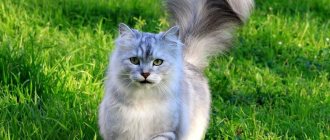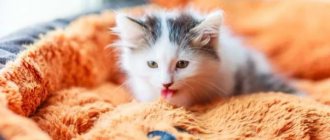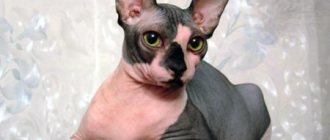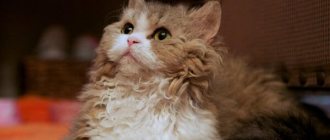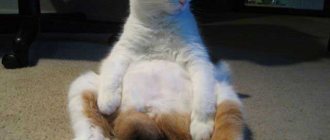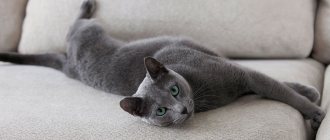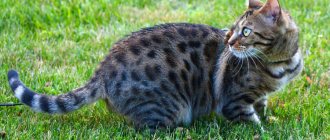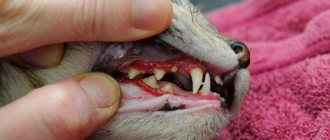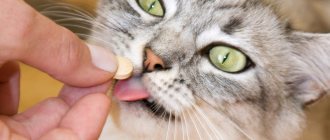Rough tongue
We all feel that same roughness when a cat licks our hands. This is explained by the fact that cats have a large number of papillae on their tongue. There are 4 types of them:
- Filiform (cone-shaped) - these are the papillae that are responsible for the brush effect. This is because they grow in the opposite direction to the sky. This helps the animal take care of its fur. In addition, your pet has the largest number of them, since this form of papillae is the most common. They occupy the anterior half of the tongue.
- Leaf-shaped are the largest papillae, which are located on both sides of the tongue.
- Mushroom - as the name suggests, they are shaped like mushrooms. They are located at the edges of the cat's tongue.
- Grooved - these papillae are located on the back of the tongue. By their arrangement they form a V-row. In front of them are the fungiform papillae.
This rough cat tongue
Such a wonderful cat organ as the tongue consists of several muscle groups that contract in different directions, giving the tongue the mobility it needs. The uniqueness of the cat's tongue is that on its surface there are some semblance of spines, which are called papillae. These spines give the cat's tongue its famous roughness, which has several useful properties, including the ability to use the tongue as a self-moistening brush, which is very useful when licking fur.
In addition, the cat's tongue has such useful functions as:
- measuring food temperature;
- food tasting;
- removing food debris from the animal’s face and mouth;
- assistance in daily care of your fur coat;
- assistance in swallowing food;
- assistance in the process.
A cat's tongue has a number of useful functions, such as drinking liquids
What should a cat's tongue be like?
If the cat is healthy, the color of its tongue will be pink. But if the color of the tongue changes in one direction or another, or if it changes its shape, then this can be considered as evidence of health problems, the danger and nature of which must be assessed by a veterinarian.
Why is a cat's tongue rough?
The roughness of a cat's tongue is associated with the papillae located on its surface. All of them can be divided into four types:
Cone-shaped (filamentous) papillae. They are the most common form of papillae. They grow in the opposite direction to the sky, and are essential in grooming. They are located mainly on the front of the tongue. It is they who create the feeling of roughness, well known to cat lovers, when a cat licks, for example, a person’s hand. Leaf-shaped papillae. Among all types of papillae, they are the largest in size. They are located in two groups on each side of the tongue in front of the circumvallate papillae, which will be discussed below. Fungiform papillae. As the name suggests, they are similar in shape to a mushroom and are located on the sides of the cat's tongue. Vital papillae. Found on the back of a cat's tongue. In a V-shaped row they are located behind the fungiform papillae.
What about a cat’s sense of taste?
If a cat’s sense of smell is unusually developed compared to a human’s, then they have significantly fewer taste buds. There are only 473 of them, while people have nine thousand of them! Taste buds are located on the groove-shaped, mushroom-shaped and leaf-shaped papillae, but they are absent on the filiform papillae.
Whether cats are able to distinguish sweet tastes or not is not yet known. Some people express the opinion that cats can feel this taste, it’s just that it is poorly developed compared to the sense of bitter, sour or salty.
In addition, a cat's tongue has developed sensitivity to temperature and the most preferred temperature is 30 degrees Celsius. This is why cats do not like food taken straight from the refrigerator.
Tongue diseases in cats
Among the cats that can affect the condition of their tongue are the following:
- Glossitis is inflammation of the tongue.
- Foreign bodies - the tongue can be injured by fragments of claws, thorns accidentally falling into the oral cavity, or a thread accidentally wound around the tongue.
- Ulcers – These can be caused by viral infections or eosinophilic granuloma.
- Cancer - first of all, of course, tongue cancer is dangerous.
Why do some cats like to stick out their tongues?
Why do some cats like to stick out their tongues?
It is a fairly common occurrence and, as a rule, it can be observed after the animal has slept or after licking its fur coat. Usually only a small part of the tongue sticks out, and not as much of it as possible. In this case, there is nothing to worry about - this is a completely normal phenomenon - for some reason the cat simply forgot to return its tongue to its place.
Have you ever been licked out of excess by your beloved cat? If so, then you probably noticed how rough her tongue is. Sometimes it feels like your skin is being rubbed with sandpaper! Owners of dogs whose tongue feels completely smooth to the touch are usually especially surprised.
The roughness of a cat's tongue is given by capillary papillae - keratinized sharp projections.
on its surface, directed back towards the larynx. First of all, a cat needs them in order to bring beauty: after all, thick fur cannot be combed out exclusively with claws. Therefore, the protrusions on the tongue work like the teeth of a comb: the cat licks itself, they additionally comb the fur and fluff.
In addition, scientists say that a rough tongue helps the cat - a predator, as we know - to better separate meat from the bones of its prey and, accordingly, eat more of it.
But a rough tongue also has one very serious drawback.
. Due to the fact that the capillary papillae are directed inward and not outward, the cat cannot spit out what is caught on them. In such a situation, the cat reflexively begins to swallow, and from this, what gets on the tongue goes even deeper into the animal’s throat and stomach. This is how cats swallow whole threads with needles that pierce the stomach, or Christmas tree rain, which is not digested by the digestive system and can lead to intestinal obstruction. Remember this and hide dangerous objects away from your pets! If you are not already familiar with the complete list, be sure to read and remember it.
Home » Tatyana O » A cat’s tongue under a microscope. Cat tongue
Difficulties that the special structure of the tongue creates for cats
A cat is a very neat animal; it always keeps its fur in order. Observe her behavior. Before curling up into a cozy ball, a cat will certainly groom its fur, wash its face with its paw and its tongue plays the most important role in this matter.
Its entire surface is covered with small points that resemble hooks. They are directed towards the pharynx, covered with keratin (our nails are made of this substance). That is why, by licking you, showing its love and tenderness, a cat can cause minor pain, discomfort, small hooks scratch like sandpaper.
Cats are given the opportunity to carefully care for their fur, which cannot be said about dogs; they do not have such sharp hooks on their tongues, they are not able to untangle tufts of fur. It is worth noting that although cats have such an effective grooming tool, they do not always use it. Very often, lazy cats, overweight cats, sick animals, or simply spoiled, self-satisfied specimens do not bother to lick all areas of the body. They often leave this work to their owners.
If you have already taken on the responsibility of a cat caretaker, then carefully inspect the fur to avoid the formation of stray lumps (tangles).
Due to the constant need to maintain a cat's image, the structure of the tongue has undergone significant changes in the process of evolution.
This muscular organ, on its surface, has many keratinized papillae, which are curved towards the animal’s esophagus. The tongue is extremely rough to the touch, so it reminds some people of sandpaper. Therefore, the affection of a domestic cat is sometimes very strongly felt by its owner. The special structure of this muscular organ gives it many functions necessary for the life of cats.
All members of the cat family are predators, even cute domestic cats. It is not surprising that the most desired dish for these creatures is meat. Often cats want to eat the remains of meat from the bone, and the special structure of the tongue again helps to fulfill this desire.
With the help of this organ, as if using sandpaper, you can very carefully remove all, even hard-to-reach, pieces of meat.
If you pay attention to how a cat drinks liquid, you may be very surprised at how deftly and quickly the animal sends drops of moisture into the esophagus. This ability is also provided by the structure of the tongue. It is the roughness of this organ that helps drops of liquid, accumulating on its surface, not to roll back, but to enter the stomach.
In the wild, representatives of this family prefer to hunt for prey. After the hunted object is caught, it needs to be butchered. During this operation, sometimes cats lack claws and teeth, then the tongue comes to the rescue. Its hard surface makes it possible to cope with the skin or feathers of prey, more thoroughly separate it and get to hard-to-reach but desirable pieces of meat.
Unfortunately, in addition to the positive aspects, the special structure of the tongue of cats can negatively affect the health of animals.
Due to the presence of ossified protrusions on the muscular organ, bent towards the esophagus, cats are forced to swallow licked hairballs. Ideally, they should either come out naturally or be regurgitated by the cat. But sometimes, due to the large volume of wool, these lumps are pressed together, which can cause stomach or intestinal obstruction. In this case, only laxative or surgical intervention can help.
Therefore, owners of long-haired cats should pay special attention to regular brushing of their pets.
Another danger due to the special structure of the tongue of felines is that they are not able to spit out small smooth objects back, since they seem to stick to the protrusions bent back. For example, if a cat accidentally swallows a shiny and eye-catching holiday rain, the animal will not be able to expel it back without outside help and, under unfavorable circumstances, the rain can injure the intestines.
A cat's strong, long, spine-covered tongue performs many functions. Based on the condition of this organ, an attentive owner may notice that the cat is sick. For example, if an ulcer appears on a cat’s tongue, calcivirosis is suspected. Knowing what a healthy cat’s tongue should look like, how cats use their tongue in a given situation, why a cat sticks out the tip of its tongue and other useful “little things”, the owner better understands his pet.
The cat's tongue, like the human tongue, consists of many transverse and longitudinal muscles, with the help of which our pets can not only extend and hide their tongue in the mouth, but also move it in different directions and fold the tongue into a ladle. The latter is especially convenient when drinking - water is retained in the recess without splashing out of the mouth.
One of the reasons why a cat sticks out the tip of its tongue is a function of thermoregulation. The wet tongue quickly releases some of the heat accumulated by the cat's body, somewhat easing the pet's condition in extreme heat. If the pet is very hot, the cat breathes heavily with its tongue hanging out. For dogs, this behavior is the norm, but for cats it is a signal that the ambient temperature has reached a critical norm. If you don’t help your pet, it’s possible.
Although the reason why a cat sticks out the tip of its tongue may be much more banal - the pet recently ate or washed itself, and simply “forgot” to put its tongue in its mouth. Owners of Persians and exotic cats notice this especially often - the cat sticks out its tongue, as if teasing others. It's all about the shortened bones of the skull: the shape of the muzzle has been changed by selection, as well as the structure of the jaws - the tongue either does not fit in the mouth, or the tip sticks out between the teeth (malocclusion, in which the cat shows the tongue, which normally rests from the inside against the teeth tightly interlocked when the mouth is closed ).
An inexperienced owner, especially if he has previously had close contact with dogs, is always surprised why a cat has a rough tongue. The touch of a cat's tongue can even be unpleasant - the surface of this organ is so hard and prickly. Residents of Ancient Rus' did not have the opportunity to examine a cat’s tongue in close-up, but the tactile sensations were enough for them to give the cat’s tongue the apt nickname “grater.”
Knowing why a cat has a rough tongue, it is not difficult to imagine what happens to tinsel or thread that gets into the cat’s mouth: the pet cannot spit out the thread (the “spikes” on the tongue that hold a thin foreign object interfere). The cat swallows thread or tinsel - there is simply nothing left for it. Having noticed this, you should not pull the end of the thread: carefully cut off the visible part and give your pet a couple of tablespoons of Vaseline oil.
We suggest you read: How to understand that a cat is dying - signs and causes
If you look at a cat’s tongue close up, you will notice that in addition to “spikes”, it is covered with short “sticks”, flat dots and other “growths” - these are also papillae, and they all perform certain functions. In particular, many of them are equipped with taste chemoreceptors, which allow the cat to sense salty, sour and bitter tastes.
The taste organ in cats is extremely multifunctional: it not only helps chew food, but is also indispensable for personal hygiene. The reason why cats have a rough tongue lies in its specific structure. If you observe a cat's tongue under a microscope, you will find that it is extremely uneven and covered with sharp tubercles. All this is no coincidence and provides invaluable benefits to the cat.
Many people believe that a cat's tongue is also used as a spoon to lap up water. Although the tongue is an important part of the drinking process, it was only recently that scientists made an incredible discovery about exactly how the lapping process occurs.
Using high-speed imaging, scientists were able to understand what happens when a cat drinks water. Instead of curling their tongue into a spoon, cats actually twist the tip of their tongue in the opposite direction and then quickly flick it across the surface of the water.
How do cats drink water? Slow motion
Many people believe that a cat's tongue is also used as a spoon to lap up water. Although the tongue is an important part of the drinking process, it was only recently that scientists made an incredible discovery about exactly how the lapping process occurs.
Using high-speed imaging, scientists were able to understand what happens when a cat drinks water. Instead of curling their tongue into a spoon, cats actually twist the tip of their tongue in the opposite direction and then quickly flick it across the surface of the water.
A cat's tongue consists of several muscle groups that move in different directions. Cat tongue
is unique in that its surface is covered with what appear to be spines (called papillae) forming a rough surface that acts like a brush when licking the fur.
The cat's tongue has several functions, such as assisting in the cat's daily grooming, removing food debris from the cat's mouth and face, tasting food, and measuring the temperature of food. The tongue is used when swallowing food, and also drinks with its help.
Healthy is pink. Any change in the color or shape of your cat's tongue indicates a problem that should be evaluated by a veterinarian.
Why does a cat have a rough tongue?
This is due to the papillae on the surface of the tongue. There are four types of papillae:
Filiform papillae (cone-shaped) are the most common form of papillae. They grow in the opposite direction to the roof of the mouth and help the cat with grooming. They are located on the front half of the tongue. And they are what cause the grating sensation when your cat licks you.
The foliate papillae are the largest of all the papillae of the cat's tongue. They form two groups on either side of the tongue, in front of the circumvallate papillae.
Fungiform papillae – as the name suggests, they are shaped like a mushroom and are located on the sides of the tongue.
The circumvallate papillae are located on the back of the cat's tongue. They are located behind the fungiform papillae in a V-shaped row.
Cat's sense of taste
A cat's sense of smell is much more developed than ours, but cats have relatively few, only 473, compared to humans, who have 9,000. Taste buds are located on the foliate, fungiform and circumvallate papillae of the tongue, but not on the filiform papillae.
It is not yet clear whether cats sense. Some believe so, although these sensations are not at all developed compared to the sensations of salty, sour and bitter.
A cat's tongue is also sensitive to temperature, with the preferred temperature being around 30*C. It is useful for owners to know that cats do not like to eat food directly from the refrigerator for this reason.
Tongue diseases in cats
There are several cat diseases that affect the condition of the tongue.
- Glossitis - inflammation of the tongue
- Ulcers - can be caused by some viral infections, the tongue can also affect
- Foreign body - bone fragments can injure the tongue, a thread can accidentally wrap around the tongue.
- Cancer – Cats can get tongue cancer.
Why does a cat stick out its tongue?
This happens quite often, as a rule, if the cat licked its fur before, or after sleep. A small part of the tongue remains protruding from the mouth. This is normal and nothing to worry about - the cat simply forgot to put her tongue back.
In cats with short jaws, such breeds as, or
A cat is an amazing creation of nature. No animal is as expressive in the manifestation of feelings as this beast. A cat conveys all its emotions and attitude through facial expressions, body movements, sounds, and smells.
These furry purrs can convey information in a variety of ways: using their ears, tail, or other gestures and sounds. Now let's talk about what the habits of a domestic cat are. If you are the owner of a furry pet, you have probably noticed something interesting behind it. So we'll look at how to learn
Functions of a cat's tongue
The cat's tongue consists of transverse and longitudinal muscles that provide its flexibility and mobility. Cats can pull it strongly, move it in different directions, and roll it into a ladle shape (for example, while drinking). Primarily, this organ is used for eating. However, it also provides thermoregulation.
The upper layer of the tongue is covered with special hard papillae that resemble thorns. The animal needs them not only to hold food or drink in its mouth, but also to thoroughly clean the fur, remove accumulated dirt and large insects. Thanks to this property, cats practically do not need to be washed, unlike dogs.
What functions does the rough tongue of cats and cats perform?
The tongue of cats, as an effective tool for grooming, also has its pitfalls. Imagine that you are combing your hair in a hurry, as a result, some part remains on the comb. The same thing happens in cats, only when they fall out, the hair remains on their rough tongue. Subsequently, it enters the stomach and intestines, which can cause serious problems.
It’s good if the lumps form, the cat will be able to burp, or they will come out with feces. Otherwise, the matted fur may not come out, and then you will have to resort to laxatives or even surgical intervention. To avoid such problems, carefully groom your pet, especially if it has very long fur. Comb out the dead layer, so it will be easier for the cat to lick itself.
Hooks on a cat's tongue help keep food in the mouth, this can be considered a positive quality.
If you notice that your cat is licking something slippery (thread, tape), make sure that it does not swallow it, as there is a high probability that the object will get caught in its mouth. In its shape and structure, a cat's tongue can be compared to a spoon; its shape makes it easy to lap up liquids.
In addition to all this, the cat's tongue serves as a heat dissipator. In extreme heat or when there is excessive stress, the animal breathes often, sticking out its tongue, this helps to cool the body. Having gone through long stages of evolution, the cat’s tongue has turned into an indispensable tool, so be patient with your pet’s caresses when he can lick your face with his “sandpaper.”
Do you have pets? Many people who own animals say their lives are enriched. Whether it's a dog, cat, turtle, fish or something more exotic, pets can make life more fun and exciting.
For example, when you return home after a hard day at work, nothing compares to an excited dog happily waiting for its owner. That wagging tail can turn even the worst day upside down. And dog licks will not leave anyone dry.
Of course, if you have a cat, it's unlikely to greet you with a wagging tail. Instead, she may climb into your arms for a gentle hug. And you probably don't want your cat to lick you! Why? Have you ever felt the touch of a cat's tongue? It's rough as sandpaper!
A cat's tongue is covered with papillae, which are small, hook-shaped, sharp projections. They are directed towards the cat's larynx. Papillae are similar to hair because they are made of keratin, the same substance that makes up our nails.
Under a microscope, a cat's tongue appears as a rough surface filled with thousands of tiny teeth. Although they make a cat's tongue very rough, the papillae play an important role in the life of these animals.
Cats tend to take very good care of their fur and spend a lot of time doing it. And how do they do it? Like this! They lick the fur with their tongue, and the papillae act in the same way as a regular comb.
Unfortunately, the papillae have a disadvantage. Due to their shape, the papillae tend to accumulate hair. Anything that gets stuck on a cat's tongue is usually swallowed. This is why many cats sometimes have to regurgitate hairballs that accumulate in their throats and stomachs.
The papillae are also important for hunting and eating. Although cats have strong jaws, the papillae help cats hold prey in their mouths. When it's time to eat, the papillae also allow cats to pick up small pieces of food that might otherwise fall out.
If it is closed or slightly open, then this is a sign of bliss. An open mouth with teeth raised in a grin means that the cat wants to bite.
https://www.youtube.com/watch?v=https:accounts.google.comServiceLogin
A “grin” or “Flemin smile” is a sign of interest in the smell. A yawn is complete relaxation. A sign of confusion is rapid licking of the lips.
If a cat reaches out its paw to your face, then it is asking for affection and attention.
Wide-open pupils indicate fear.
When a cat stomps its paws, slightly releasing its claws, it means that it is very happy, adores you, and wants to do something nice.
When a cat squints, it demonstrates calmness and peacefulness.
Does your pet quickly lick its lips and nose? She's confused.
Beating its tail means it is angry or hunting.
Large eyes and pupils indicate that he is angry or playing.
A tail with a trumpet is a sign of joy, a kind of greeting.
If she moves the tip of her tail, it means she is interested in something.
The cat stares at you - this is a challenge (usually to play tag).
Quick licking of the front paw is a sign of excitement.
A tail frozen at the bottom indicates disgust or disappointment.
The fact that a cat rubs its head against a person speaks of love, devotion and a thirst for affection.
Strong tail swings in different directions are a sign of irritation, small waving indicates curiosity and excitement.
If the ears are pressed to the head, then the pet is preparing for an attack. If at this time the cat makes circles with its tail, it means that it is irritated.
The fact that the pet is interested in something or is ready for action is indicated by the fact that the whiskers are directed forward.
A sign of curiosity is the ears are vertical.
If the cat looked around and then began to lick itself thoroughly, this indicates complete or feigned (during play) calm.
We suggest you read: Cat bite - What to do if bitten by a cat, first aid and treatment methods
https://www.youtube.com/watch?v=ytadvertiseru
The tail is raised vertically, the tip is relaxed - a sign of joyful excitement.
If a cat is pressed to the floor, then it is either hiding or preparing to attack.
The fact that your pet is rubbing against your legs means that it is marking you. Purrs have scent glands on their faces. All her relatives should smell “their” scent.
A cat's meow is a greeting or a request.
This cat's behavior indicates a warning: the eyes are large, the ears are back.
If a cat scratches its claws loudly, then it wants to be paid attention to.
Is your mustache down? This means that the pet is worried about something, is sad, or is sick.
Does the cat raise its tail and turn its back towards the owner's face? Know that this is a greeting gesture between cats (the dominant one sniffs first). Also, such behavior is a sign of respect and trust.
The cat's purring indicates calmness.
Rumbling indicates dissatisfaction.
If you hear a short cry, then the cat is scared of something.
Intermittent meowing is a response to human contact.
Is the cat rolling on the floor? Know: this is how she demonstrates her attractiveness.
Howling indicates that the cat is angry.
Fully extended paws indicate self-confidence, while bent paws, on the contrary, indicate uncertainty and timidity.
Hissing is a sign of readiness to fight, a kind of warning to your opponent.
A muffled purring that ends with a dissatisfied rumbling is a sign that patience has run out.
A pressed, bunched mustache speaks of concern and anxiety.
If a cat arches its back and grumbles, then know that in this way it scares its opponent, and also shows irritation and readiness to defend itself.
The restrained rumbling of a nursing pet is a warning to babies from possible danger. If the purring ends in a raised tone, then she warns people or other creatures not to approach the kittens.
When a cat is relaxed and calm, its whiskers hang down on the sides of its face.
If an animal runs away from you at a fast pace, with its head drawn in, then it means it has done something bad.
When a cat hides its head in a corner, it is hiding like this.
A dissatisfied purr is a sign that something is bothering your pet.
Is the cat sitting with its paws tucked in, its tail wrapped around itself? Know that she is simply observing.
If your pet dances, lifting her front paws off the floor, then know that she is greeting someone she loves.
The functions of a cat's tongue are quite obvious. With its help, the animal takes care of itself by licking its fur. It also removes food debris from the mouth and face. We have all seen how a cat washes itself: after wetting its paw, it runs it over its face. These manipulations help cleanse it.
In addition, with the help of its tongue, the cat tastes the food offered to it and determines its temperature. If these criteria do not suit her, she will not eat the food you give her.
The peculiarity of the structure of the papillae of a cat's tongue provides it with the ability to drink water and liquid food. Running its tongue along the surface of the water, the cat lifts it, creating a trickle, which it drinks.
In addition to holding food, combing and cleaning cat hair, a pet's tongue performs a number of the following functions:
- Thermoregulation of the cat's body. In hot weather, the pet actively licks the fur and the tip of its nose so that the saliva, evaporating, lowers its body temperature.
- Health status indicator. White color – disruption of the functioning of the digestive system. Black – lack of vitamins in the animal’s diet. Gray or pale brown - problems with the cat's respiratory system. A yellow coating indicates liver or kidney disease in the animal. Pale tongue – heart or blood vessel disease. Ulcers, spots or other formations are a reason to take your pet to the veterinary clinic.
Functions
In addition to holding food, combing and cleaning cat hair, a pet's tongue performs a number of the following functions:
- Thermoregulation of the cat's body. In hot weather, the pet actively licks the fur and the tip of its nose so that the saliva, evaporating, lowers its body temperature.
- Health status indicator. White color - disruption of the functioning of the digestive system. Black - lack of vitamins in the animal’s diet. Gray or pale brown - problems with the cat's respiratory system. A yellow coating indicates liver or kidney disease in the animal. Pale tongue - heart or blood vessel disease. Ulcers, spots or other formations are a reason to take your pet to the veterinary clinic.
A cat is an amazing creation of nature. No animal is as expressive in the manifestation of feelings as this beast. A cat conveys all its emotions and attitude through facial expressions, body movements, sounds, and smells.
These furry purrs can convey information in a variety of ways: using their ears, tail, or other gestures and sounds. Now let's talk about what the habits of a domestic cat are. If you are the owner of a furry pet, you have probably noticed something interesting behind it. So we'll look at how to learn
The positive aspects of having a special language during the hygiene process
The special structure of the tongue greatly helps to facilitate the process of hygiene. Cats usually lick themselves in two cases - when they want to get rid of foreign odors and when they want to tidy up their fur, which they think is dirty. There are many such cases, so these creatures lick themselves quite often. Keratinized little projections on the tongue help in this process, acting like a hair brush.
As is known, most cats, especially artificially bred breeds, are not adapted to the climate of northern latitudes. But they are not comfortable withstanding too hot temperatures. Like people, these creatures also suffer from heart disease, so an elevated temperature for them can be not only harmful, but also dangerous.
The special structure of the tongue, namely the hard protrusions on it, helps to create a “dispersion” of the flow of hot air from the environment. That is why, in extreme heat, you can see cats with their mouths open. The special structure of the tongue helps cats maintain thermoregulation at an acceptable level for them.
Swallowing objects
The reason why cats have a rough tongue is their tendency to swallow various inedible objects. Everyone noticed the animal’s love for Christmas tree tinsel, laces and other hanging objects.
This all happens because, due to the structure of the tongue, a cat, having taken an object into its mouth, can no longer get rid of it. And the only option they have is to swallow the object. The papillae of the tongue simply push the object deep into the digestive tract.
This situation is not always harmless. For example, cats love to swallow needles. The animal is interested in the thread on the needle. During the game it turns out that it is not separated from the tongue. It becomes simply impossible to remove the thread. Due to the direction of the papillae and swallowing movements, the thread gradually moves deeper into the pharynx, carrying the needle with it.
Care tool
Thanks to the hard filiform papillae growing in the opposite direction, towards the pharynx, the cat's tongue is a kind of brush. It allows you to comb the fur in the desired direction, straighten the hairs that have bunched up in lumps and at the same time remove all foreign objects tangled in the fur coat.
However, individual, too lazy or spoiled specimens do not bother themselves with tedious combing, leaving this function to a caring owner. In this case, it is necessary to regularly examine and tidy your pet so that its fluffy coat does not become covered with tangles.
The owner must take care of his pet’s hair even if his breed has thick and long hair. Thorough licking of such a rich coat is difficult for even the most hardworking cat to cope with. In addition, the hard papillae collect shed hair, which the cat is forced to swallow.
READ What to do if your cat has eczema
A buildup of hair in the digestive system can cause serious health problems for your pet. Therefore, comb out lost hairs regularly, especially during shedding. By doing this, you will save the animal from unnecessary suffering, and yourself from worrying about your pet’s well-being.
Feel
Why do cats have rough tongues? Because it is dotted with papillae. But this not only gives the animal additional positive characteristics. It also increases the sensitivity of the tongue. If a cat injures its tongue for any reason, then this pain will exceed the sensations that the cat would experience if another part of the body was injured. The tongue turns out to be much more sensitive than the paw, tail or ear.
By the way, due to the fact that the cat has a rough tongue, its teeth always remain clean and sharp.
It’s also no secret that the tongue is a storehouse of taste buds. The receptors on the cat's tongue are also responsible for distinguishing taste, but in a slightly different way. Firstly, a cat has much fewer receptors themselves. If a person has about 9000 of them, then an animal has only 473. Secondly, despite the smaller number, they distinguish tastes more sharply and strongly.
In addition, due to the peculiarities of the tongue, cats provide themselves with the function of thermoregulation. You've probably often noticed that during hot weather, your pet sticks its unit out. She does this to evaporate excess moisture from the body, since the cat does not have sweat glands that provide this. This way the pet lowers its body temperature.
The structure of the taste organ in cats
The rough tongue of cats consists not only of capillary, but also elongated and mushroom-shaped papillae. They are located in certain areas of the cat's organ. The taste buds are located in these papillae.
The animal has a long and very mobile taste organ. It is flat and can take any shape: when a pet laps milk, the cat's tongue resembles a kitchen ladle. The keratinized projections, which can be examined in detail only under a microscope, help cope with licking fur and eating meat located in hard-to-reach places on the bones.
We suggest you read: The cat has a tumor on her chin
Pets tend to swallow their fur, threads and other small objects, since the capillary papillae are directed towards the larynx and it is impossible to separate them, so the owner must regularly comb the cat and not allow it to play with small materials at hand.
A cat's taste organ is made up of muscle tissue and the mucous membrane that covers the muscle. The scales help retain food that the cat licks off and clear dirt from the fur when the cat uses its tongue to clean itself.
Worship of cats in Ancient Egypt - interesting facts
Why is a cat given a rough tongue by nature?
The cat does not have hands to pick up food or lift drink containers. However, without food the animal will simply die. Thanks to its rough tongue, the cat can lap up water and eat. Liquid and liquid food are retained between the protrusions, without rolling back from the surface, they are directed into the larynx.
The capillary papillae give the animal's tongue its characteristic roughness. These are keratinized projections curved towards the esophagus. Many growths cover the entire surface of the tongue and create a rough feeling. The organ feels like sandpaper to the touch.
Communicating with facial expressions
This type of communication can include, for example, the fact that a pet greets its owner, begs for food, or expresses protest. The language of cats is an amazing lexicon. In each individual case, the purr produces corresponding sounds that differ in tone, strength or timbre. Note that the state of pain, aggression and fear is accompanied by lower sounds, and complacency and satisfaction are accompanied by high ones.
If you know a little about the language of cats, you can understand their psychology. For example, purring means that the pet is not aggressive. With this trill, mother cats call their kittens. These animals also purr when the owner returns home.
Rumbling is a warning sound to others. Low is a sign that the cat is ready to defend itself. Snorting and hitting the ground with a paw is a signal for a fight with a more serious enemy.
Another interesting sign that a cat gives is the chattering of its teeth. This signal can be seen when it sees prey.
Meowing is conversation. however, the cat uses it very rarely when it wants to go out or eat.
How to understand the language of cats? Simple, if you know her facial expressions. The entire arsenal of cat gestures is innate. The half-closed eyes of a cat signify relaxation and tranquility. Wide eyes indicate concern.
If the environment frightens the cat. Looking point blank is a challenge, and the same thing is meant. If she looks to the side, then this is how she shows submission.
Now let's look at their meaning. The tail is particularly expressive. If it is raised up, then the animal is friendly. Remember how kittens' tails stand. Of course, upward, because they are just learning about the world, they are interested in everything new. If a cat is scared, its tail is between its paws. Fluffy is a symbol of an aggressive attitude.
Dominant cats have their tails held high, while subordinate cats have their tails lowered. If a pet knocks on the floor with it, then it becomes angry. When the tail moves quickly from side to side, this is a sign of severe aggression. Lightly waving the tip of the tail means the cat is relaxed.
Poses
Now you have become a little acquainted with what a cat’s tongue is, we will present its translator below, but for now let’s look at the poses. They are all different, depending on who they are addressed to.
The distance at which a cat feels safe around an opponent is called the “flight distance.” First she scares her enemy so that he does not cross this line. If the enemy animal crosses this line, the cat flees.
Threatening pose: the back is practically not hunched, the hair is not bristling, only slightly fluffed on the tail and withers. At this moment, the animal looks the enemy in the eyes and howls. In this position, they remain motionless for a surprisingly long time, thus the cat tries to suppress the fighting spirit of the enemy. The tail hitting the gods is a sign that a fight could start at any minute. This is followed by a paw blow to the nose. The one who attacks tries to strike the back of the enemy's head. If he succeeds, the enemy is captured.
Now let's talk about how these animals express complacency and satisfaction. Cats lying on their sides or on their backs are in a state of peace and tranquility. Another confirmation of complacency is that the paws are spread out to the sides, and the pads are compressed and unclenched; the eyes, as a rule, are half-closed at this moment.
Interestingly, the cat shows indecisiveness. This condition is always accompanied by licking. The more decisive the movements of the tongue, the more difficult the problem the pet solves at this time. Licking is a kind of calmer that removes incipient irritability.
